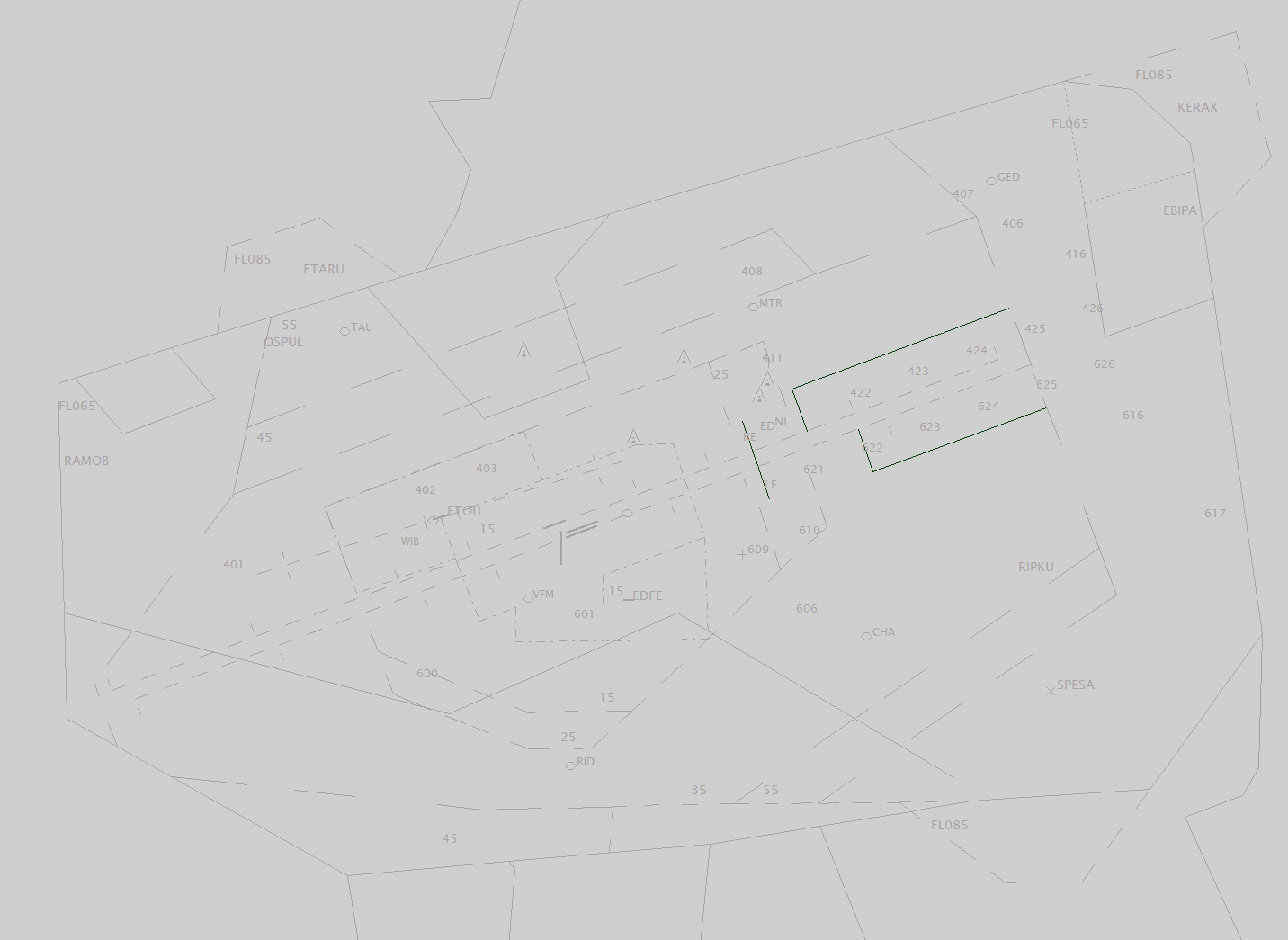Tasks Arrival
The Approach/Arrival position oversees the vicinity around larger airports. It is typically responsible for all arrivals and departures from the respective airports. The main task is to merge the different traffic flows coming from various directions and guide them with the necessary separation into the final approach.
To bring traffic safely and efficiently to the final approach, the controller has various tools at their disposal. They can use STARs, transitions, and radar vectors to achieve the necessary separation. To maintain this separation, speeds are typically used, which the pilot must adhere to. The goal of a good approach sequence is to lead the inbound aircraft to the ILS with the smallest possible separation.
If the approach controller's sector becomes too congested, causing subsequent aircraft to wait, the controller has the option to use holding patterns.
Major airports like Frankfurt or Munich often have multiple approach positions as well as dedicated controllers for departure and a feeder who exclusively manages the aircraft on the final approach (see below). At smaller airports (e.g., Frankfurt/Hahn, Dortmund), the approach controller's tasks are usually taken over by the respective center controllers in the lower airspace.
| Station | Phraseology |
| Pilot | Langen Radar hello, CFG7HX passing FL158, descending FL130, info T. |
| ATC | CFG7HX, Langen Radar identified, descend FL100, expect ILS runway 25L. |
| Pilot |
CFG7HX, descend FL100, expect ILS runway 25L. |
Feeder
The position of the Feeder (callsign "Arrival") is to bring aircraft as precisely as possible to the final approach, to then hand them over to the tower. The Arrival controller descends the aircraft coming from the center, puts them on the downwind or an appropriate heading, and hands them over to the Feeder.
Both stations must harmonize well and be familiar with each other’s positions. It’s not particularly difficult when aircraft arrive continuously so that they can be guided along the transitions and handed over to the Feeder on the downwind. However, during gaps and phases with less traffic, it becomes interesting. The Pickup needs to know when it makes sense to send an aircraft to the Feeder on a "magic heading" that brings it directly to the final approach instead of via the downwind. The Feeder must then understand what the Pickup intended with this heading.
It is important that the Pickup hands over all arrivals conflict-free. For instance, all aircraft flying behind each other and cleared to the same altitude must be set to the same speed. Two aircraft whose flight paths would eventually cross if they continued on the heading they are handed over to the Feeder must be handed over at different altitudes. It also makes sense to hand over aircraft on different sides of the runway at different altitudes so that the Feeder can safely turn them onto the final approach, in case one overshoots.
The Pickup can also hand over a "package" of two aircraft to the Feeder, but must ensure there is space on the final approach to achieve the necessary spacing between them. It is however normally the Pickup’s job to sequence the aircraft onto the downwind with spacing already in place. Note: When aircraft continuously arrive on both downwinds, they must always have double the spacing between them compared to what is needed later on the final approach, since the Feeder has to merge both downwinds into one final approach. This does, of course, not apply to airports like Frankfurt and Munich with two independent finals.
Experience is needed here as well to ensure good cooperation between Pickup and Feeder. We have the disadvantage that the two usually do not sit in the same room next to each other, so "elbow-coordination" is not possible. Therefore, care must be taken to work clearly with each other.
Departure
In addition to arrivals, all departures from an airport must also be managed by a radar controller once they are airborne. At many airports, this task also falls to the Arrival controller (e.g., in Munich and Hamburg), while at some airports there are dedicated positions that exclusively handle departures (e.g., in Frankfurt and Düsseldorf).
The main task of a Departure controller is to allow departures to climb between arrivals and then hand them over to the Center controller. Outbounds can be handed over to the radar by the tower with a minimum spacing of 3 NM, so the radar controller must pay particular attention to the aircraft’s performance and the necessary separation.
The exact procedures regarding transfer altitudes, noise abatement, and aircraft management are highly dependent on the airport and described in the respective SOP.
Normally, all departures follow a precisely defined departure route and climb to the altitude cleared by the SID. When deviations occur through headings or directs, the aircraft must be above the Minimum Vectoring Altitude (MVA) applicable in that area.
As a Departure controller, it is important to note that two departures on the same route must be handed over to the Center with at least 10 NM spacing. If this is not possible with the use of speeds and vectors/directs, different transfer altitudes can be coordinated as an exception to the LoA (Letter of Agreement). The handover must always be conflict-free, and releases are regulated via the LoA/SOP.
Additional links
- Skybrary: Structured Scan

